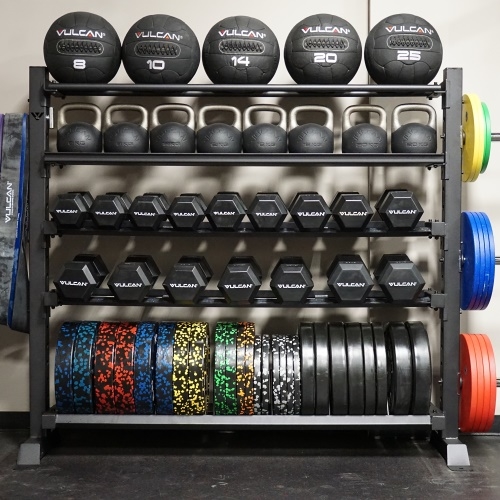Platform
Solutions
Industries
Compare
Resources
Posted by on July 14, 2023 — Updated on September 20, 2024
The equipment needed for a sports performance gym includes squat racks, sleds, turf, and more to train athletes at a high level.
Starting a sports performance gym requires careful planning and consideration to ensure you have the necessary equipment to meet the needs of your clients. Whether you are just starting out or looking to expand your current offerings, it’s important to invest in quality equipment that will help your athletes achieve optimal results. In this article, we will explore the essential equipment needed for a sports performance gym, as well as important gym maintenance considerations based on your target clientele.
Discover the essential equipment needed to kickstart your sports performance gym. Then see how the best sports performance gym software and the best business management software for gyms can help you grow and scale your gym.

When you start a sports performance gym, you need equipment! Starting a commercial sports performance gym requires a comprehensive list of equipment to cater to different types of athletes and the various areas of fitness they need to work on. Here’s a sample list:
Remember, the exact list will depend on the specific sports performance goals of your clientele. Make sure to conduct thorough research and consult with experienced professionals to get the best equipment for your gym.
Read More:
When setting up a sports performance gym, there are several pieces of equipment that are essential for creating a comprehensive training experience. These include strength training and conditioning equipment, cardio machines, weightlifting equipment, functional training tools, plyometric tools, resistance bands and cables, balance and stability equipment, Olympic lifting platforms, versatile machines, recovery and rehabilitation equipment, cutting-edge technology, and space-saving layout options.
Strength training and conditioning equipment forms the foundation of any sports performance gym. This includes items such as barbells, dumbbells, weight plates, squat racks, bench presses, and cable machines. These tools are essential for building strength, improving muscular endurance, and enhancing overall athletic performance.
Cardio machines are equally important for improving cardiovascular fitness and endurance. Treadmills, stationary bikes, elliptical trainers, and rowing machines are popular choices that cater to different preferences and fitness levels. Having a variety of options allows you to offer diverse cardio workouts that can be tailored to each individual’s needs.
Weightlifting equipment is crucial for athletes looking to increase their strength and power. Olympic weightlifting platforms, barbells, bumper plates, and lifting accessories help athletes perform exercises like clean and jerks, snatches, and various forms of weightlifting movements. Investing in high-quality weightlifting equipment is essential to ensure safety and provide the necessary support for athletes.
Functional training has gained immense popularity in recent years, and having the appropriate tools in your gym is essential. Suspension trainers, kettlebells, medicine balls, stability balls, and resistance bands allow athletes to engage multiple muscle groups simultaneously, mimicking real-life movements and enhancing overall functional strength.
Plyometric tools are specifically designed to improve explosive power and agility. Plyo boxes, agility ladders, cones, and hurdles are essential for athletes looking to enhance their speed, agility, and explosiveness. Incorporating these tools into your training programs will help athletes excel in sports that require quick bursts of power and rapid changes in direction.
Resistance bands and cables are versatile tools that allow athletes to target specific muscle groups and improve strength and flexibility. These tools can be used for warm-up routines, mobility exercises, and even higher intensity workouts. Incorporating resistance band exercises into your training programs can greatly benefit athletes of all levels.
Balance and stability equipment play a crucial role in building core strength and improving proprioception. Items such as balance boards, stability balls, wobble boards, and Bosu balls challenge athletes to stabilize their bodies while performing exercises, helping them develop better balance and stability in sports-specific movements.
Olympic lifting platforms provide a dedicated space for athletes to safely perform heavy Olympic-style lifts. These platforms have a cushioned surface to absorb the impact of dropped weights and protect the gym floor. Having dedicated Olympic lifting platforms demonstrates your commitment to providing a professional training environment and reduces the risk of accidents.
Versatile machines are excellent additions to any sports performance gym, as they allow athletes to perform multi-joint exercises and target specific muscle groups. Cable machines, smith machines, and functional trainers offer a wide range of exercise options and can be utilized by athletes of all levels, making them highly effective tools for strength and muscle development.
Recovery and rehabilitation equipment should not be overlooked in a sports performance gym. Foam rollers, massage guns, vibration plates, and stretching equipment aid in optimizing recovery and preventing injuries. These tools help athletes relieve muscle tension, improve blood flow, and promote faster recovery between training sessions.
Incorporating cutting-edge technology into your sports performance gym can provide valuable data for tracking progress and improving performance. Heart rate monitors, GPS trackers, motion capture systems, and other wearable devices can provide real-time feedback on an athlete’s performance, allowing for personalized training programs and enhancing the overall training experience.
Creating an efficient and space-saving layout for your gym equipment is crucial, especially if you have limited space. Properly organizing your equipment not only improves the flow of your gym but also ensures the safety of your athletes. Considerations such as traffic flow, accessibility, and designated areas for specific types of exercises should be taken into account when planning your gym layout.
To prolong the lifespan of your gym equipment, regular maintenance is essential. Creating a maintenance schedule for cleaning, lubricating, and inspecting your equipment will help prevent premature wear and tear, ensuring it remains in optimal condition for years to come. Additionally, educating your staff and clients on proper equipment usage and cleaning protocols will further support equipment longevity.
For those on a budget, there are several budget-friendly options available that do not compromise on quality. Second-hand equipment from reputable sellers, leasing options, and purchasing equipment in bulk are all cost-effective ways to set up your sports performance gym without breaking the bank. However, it is important to thoroughly inspect used equipment and ensure it is in good working condition before finalizing any purchases.
Lastly, designing specialized areas within your sports performance gym can enhance the overall training experience. Creating designated spaces for activities such as stretching, recovery, plyometrics, and speed training allows athletes to focus on specific training modalities while optimizing the use of your gym space. These specialized areas can be equipped with targeted tools and equipment to cater to specific training needs.
As the fitness industry continues to evolve, it is essential to future-proof your sports performance gym with adaptable and versatile equipment. Look for equipment that can easily be upgraded or modified to accommodate emerging trends and evolving training techniques. Having equipment that can adapt to changing needs will ensure your gym remains relevant and continues to attract athletes in the future.
Starting a sports performance gym requires careful consideration of the essential equipment needed to meet the needs of your athletes. By investing in quality equipment, considering your target clientele, and incorporating versatile tools, you can create a comprehensive training experience that enhances athletic performance. Additionally, incorporating cutting-edge technology, creating a space-saving layout, and implementing proper maintenance protocols will ensure the longevity of your gym equipment. By following these guidelines and considering the specific needs of your athletes, you can successfully start and grow a sports performance gym that caters to athletes of all levels.
Read More: How to Start a Fitness Business
For a sports performance gym, it’s crucial to have fitness equipment that targets specific areas of an athlete’s fitness. This includes performance exercise equipment like resistance bands, agility ladders, plyometric boxes, and free weights, which are versatile and can be used for a range of sport-specific exercises.
Key sports performance equipment items include weightlifting racks for strength training, treadmills and stationary bikes for cardiovascular endurance, and functional training equipment like kettlebells and medicine balls. This equipment is essential for athletes to train effectively in various aspects of their fitness.
Sports equipment exercises beneficial for athletes include plyometric training using boxes and hurdles, agility drills with cones and ladders, strength training with free weights and resistance machines, and cardiovascular workouts using rowing machines or ellipticals.
Sport-specific equipment items enhance athletic training by allowing athletes to focus on particular skills and fitness components relevant to their sport. For example, using a batting cage for baseball players or a vertical jump trainer for basketball athletes.
Recommended sports performance products for a well-rounded training program include balance boards for stability, resistance bands for flexibility and strength, speed parachutes for sprint training, and specialized machines like leg press or hamstring curl machines for targeted muscle development.
When selecting sports performance training equipment, consider the sports your gym will cater to and choose equipment that can help athletes improve in those specific areas. Also, look for high-quality, durable equipment that can withstand rigorous use.
Read More:





